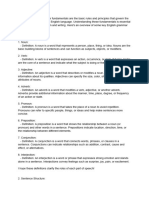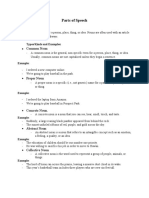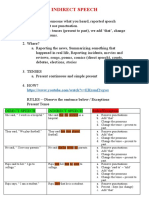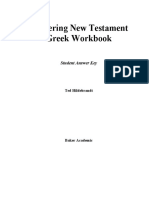Guide to Parts of Speech
Uploaded by
Dina NicasioGuide to Parts of Speech
Uploaded by
Dina NicasioGuide to Parts of Speech
1. Introduction to Parts of Speech
● The parts of speech are the building blocks of English grammar.
● Every word in a sentence belongs to one of eight main categories.
● Understanding the parts of speech helps in sentence construction, writing clarity, and
grammar accuracy.
2. The Eight Parts of Speech
1. Nouns (Names of People, Places, Things, or Ideas)
Types of Nouns:
● Common Nouns: Refer to general names (e.g., city, car, book).
● Proper Nouns: Specific names, always capitalized (e.g., Paris, Toyota, Shakespeare).
● Concrete Nouns: Things that can be seen or touched (e.g., table, dog, phone).
● Abstract Nouns: Concepts, emotions, or ideas (e.g., happiness, freedom, courage).
● Collective Nouns: Refer to groups (e.g., team, flock, committee).
● Countable and Uncountable Nouns:
○ Countable: Can be pluralized (e.g., apple → apples).
○ Uncountable: Cannot be counted individually (e.g., water, information).
Functions of Nouns in Sentences:
● Subject: The dog barks.
● Object: She bought a car.
● Possessive Form: The boy’s hat.
2. Pronouns (Replace Nouns to Avoid Repetition)
Types of Pronouns:
● Personal Pronouns: I, you, he, she, it, we, they (subject) | me, him, her, us, them
(object)
● Possessive Pronouns: mine, yours, his, hers, ours, theirs (ownership)
● Reflexive Pronouns: myself, yourself, himself, herself, itself, ourselves, themselves
(used when subject and object are the same)
● Demonstrative Pronouns: this, that, these, those (point to something)
● Interrogative Pronouns: who, whom, whose, what, which (used in questions)
● Relative Pronouns: who, whom, whose, which, that (used to connect clauses)
● Indefinite Pronouns: somebody, anybody, everything, nothing (refer to non-specific
things)
Examples:
● Incorrect: John likes John’s bike. → Correct: John likes his bike.
● Incorrect: Give it to she. → Correct: Give it to her.
3. Verbs (Express Actions or States of Being)
Types of Verbs:
● Action Verbs: Describe physical or mental actions (run, think, write).
● Linking Verbs: Connect subjects to descriptions (is, seem, become).
● Helping Verbs: Assist the main verb in tense formation (has, will, do).
Verb Tenses:
● Present: She writes.
● Past: She wrote.
● Future: She will write.
● Progressive Forms: She is writing, She was writing, She will be writing.
● Perfect Tenses: She has written, She had written, She will have written.
4. Adjectives (Describe Nouns or Pronouns)
Types of Adjectives:
● Descriptive: happy, blue, strong
● Quantitative: few, many, several
● Demonstrative: this, that, these, those
● Possessive: my, your, his, her, our, their
● Comparative & Superlative Forms:
○ Positive: strong
○ Comparative: stronger
○ Superlative: strongest
Examples:
● Incorrect: She is more prettier than her sister. → Correct: She is prettier than her sister.
5. Adverbs (Modify Verbs, Adjectives, or Other Adverbs)
Types of Adverbs:
● Manner: slowly, happily, well
● Place: here, there, everywhere
● Time: now, yesterday, soon
● Frequency: always, never, often
Examples:
● Incorrect: He ran quick. → Correct: He ran quickly.
6. Prepositions (Show Relationships Between Words)
Common Prepositions:
● Location: in, on, at, under, between
● Time: before, after, during
● Direction: to, into, onto, toward
Examples:
● Incorrect: She is in the bus. → Correct: She is on the bus.
7. Conjunctions (Connect Words, Phrases, or Clauses)
Types of Conjunctions:
● Coordinating: and, but, or, so, yet, for, nor (connect equal ideas)
● Subordinating: because, although, since, if, while (connect dependent ideas)
● Correlative: either/or, neither/nor, both/and
Examples:
● Incorrect: I will go if it rains, but I will go if it is sunny. → Correct: I will go whether it
rains or it is sunny.
8. Interjections (Express Strong Emotion)
Common Interjections:
● Surprise: Wow! Oh!
● Happiness: Yay! Hooray!
● Pain: Ouch! Oh no!
Examples:
● Incorrect: Wow. That’s amazing! → Correct: Wow! That’s amazing!
You might also like
- Parts of Speech-Nivashini Tuition ClassNo ratings yetParts of Speech-Nivashini Tuition Class22 pages
- Graphic Organizers Grammar Parts of SpeechNo ratings yetGraphic Organizers Grammar Parts of Speech6 pages
- Quick-Reference-Guide-to-Essential-English-Grammar-RulesNo ratings yetQuick-Reference-Guide-to-Essential-English-Grammar-Rules12 pages
- PARTS OF SPEECH - MORPHOLOGY AND SYNTAXNo ratings yetPARTS OF SPEECH - MORPHOLOGY AND SYNTAX43 pages
- The Eight Parts of Speech in English (PDF) ?No ratings yetThe Eight Parts of Speech in English (PDF) ?5 pages
- Aec 1 Materials Ku2aeceng105 English in Context.docxNo ratings yetAec 1 Materials Ku2aeceng105 English in Context.docx57 pages
- 7 Days to Grammar Excellence: How to Master English from Beginner to AdvancedFrom Everand7 Days to Grammar Excellence: How to Master English from Beginner to AdvancedNo ratings yet
- Spanish Workbook -- Grade 6 -- semester INo ratings yetSpanish Workbook -- Grade 6 -- semester I37 pages
- Unit 2: Morphology: Morphemes and AllomorphsNo ratings yetUnit 2: Morphology: Morphemes and Allomorphs14 pages
- Zero and First Conditional ppt with activities (1)No ratings yetZero and First Conditional ppt with activities (1)9 pages
- Le Passe Compose: The Past Tense: Onjugation With AvoirNo ratings yetLe Passe Compose: The Past Tense: Onjugation With Avoir5 pages
- Scholastic Sanskrit A Manual for Students First Edition Gary A. Tubb all chapter instant download100% (1)Scholastic Sanskrit A Manual for Students First Edition Gary A. Tubb all chapter instant download77 pages
- English: Class: Iii Classification of NounsNo ratings yetEnglish: Class: Iii Classification of Nouns9 pages
- COMPARATIVE AND SUPERLATIVE - OUP - g2g - Jan14 - Ogs4 - Print0% (1)COMPARATIVE AND SUPERLATIVE - OUP - g2g - Jan14 - Ogs4 - Print7 pages
- Teacher's Name: Carolina Carrión Vera.: Formatted: English (United States)No ratings yetTeacher's Name: Carolina Carrión Vera.: Formatted: English (United States)4 pages
- Basic Tense With Spoken Tricks Gift For The TeacherNo ratings yetBasic Tense With Spoken Tricks Gift For The Teacher9 pages

























































































